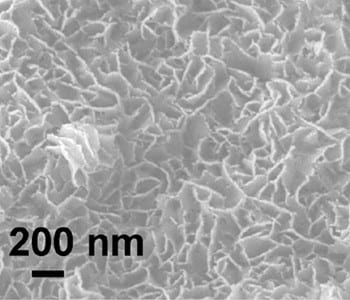Researchers from Nanyang Technological University, Singapore, and Xi’an Jiaotong University, China, report on a simple two-step synthesis to design hybrid nanocomposites based on reduced graphene oxide (rGO) and ultrathin ZnCo2O4 nanosheets as advanced anode material for high-performance lithium-ion batteries (LIBs).
Transition metal oxides (TMO), in particular spinel-type cobalt oxides, are interesting alternatives to graphene-based anode materials due to their higher theoretical capacities. Partial substitution of cobalt with less expensive and eco-friendly metals is desirable, and among a variety of ternary metal oxides ZnCo2O4 shows great potential with enhanced cycling stability and good environmental benignity. Practical applications, however, are still limited because of the intrinsic poor electrical conductivity and low cycling stability resulting from the immense volume changes during the insertion/extraction process of Li. To circumvent these issues, the use of a matrix with high electrical conductivity that can withstand the volume variations during prolonged cycling has been investigated recently. Thereby, graphene and graphene oxide are highly promising due to their high electrical conductivity, mechanical flexibility, large specific surface area, and good chemical stability.
With this aim in mind, Xiong Wen Lou and co-workers demonstrate that hierarchical hybrid structures of rGO-supported ZnCo2O4 nanosheets, rGO/ZnCo2O4, can be fabricated by a simple two-step synthesis comprising the growth of precurser nanosheets on the rGO surface and subsequent thermal annealing. Thereby, the addtition of trisodium citrate (TSC) to the reaction solution plays a crucial role in the formation of the hierarchical hybrid structure of ultrathin ZnCo2O4 nanosheets on both sides of rGO through a possible coordination effect between the metal ions and the functional groups of TSC. The morphology can be tuned by controlling the TSC concentration, allowing for an optimal morphology consisting of densely standing and interconnected ZnCo2O4 nanosheets on the surface of the rGO sheets.
This hybrid nanostructure is beneficial to facilitate charge transport and accomodate the drastic volume variations during prolonged cycling. High reversible lithium storage capacities of around 960 mAh g-1 over 100 cycles at a current density of 90 mA g-1 and excellent capacity retention at increased current densities are observed. The synthetic procedure reported here provides a facile strategy to fabricate hybrid structures with a controlled nanomorphology for the development of advanced anode materials with enhanced cycling stability and lithium storage properties.
Advanced Science is a new journal from the team behind Advanced Materials, Advanced Functional Materials, and Small. The journal is fully Open Access and is free to read now at www.advancedscience.com.

















